

Now You Can 3D Print Completely Functional Human Skin. Regenerative Medicine: Scientists Have Successfully Engineered Functioning Human Nerves. In Brief Using pluripotent stem cells, scientists have grown intestinal tissues with functional nerve systems.The synthesized tissue was used to study Hirschsprung's disease, a condition that impacts about 200,000 Americans yearly.
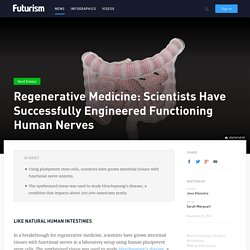
Like Natural Human Intestines In a breakthrough for regenerative medicine, scientists have grown intestinal tissues with functional nerves in a laboratory setup using human pluripotent stem cells. The synthesized tissue was used to study Hirschsprung’s disease, a congenital condition where nerve cells are missing from the colon, causing complications in passing stool. The research is detailed in Nature Medicine. A pluripotent stem cell is a precursor cell to all the other types of cells in the body. The tissues were transplanted into mice. The biggest biotech discovery of the century is about to change medicine forever. In Brief When they initially crafted molecules that could enter a microbe and precisely snip its DNA at a location of the researchers’ choosing, they had no idea of its enormous potential.
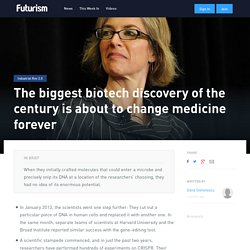
In January 2013, the scientists went one step further: They cut out a particular piece of DNA in human cells and replaced it with another one. In the same month, separate teams of scientists at Harvard University and the Broad Institute reported similar success with the gene-editing tool.A scientific stampede commenced, and in just the past two years, researchers have performed hundreds of experiments on CRISPR. Their results hint that the technique may fundamentally change both medicine and agriculture.Thanks to the speed of CRISPR research, the accolades have come quickly. Last year MIT Technology Review called CRISPR “the biggest biotech discovery of the century.” Reinventing Health Care: The Coevolution of Biology, Technology, and …
Human Genetic Engineering. What forms of genetic engineering can be done in human beings?
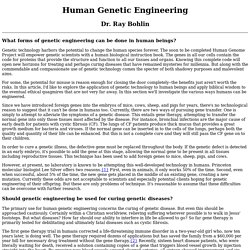
Genetic technology harbors the potential to change the human species forever. The soon to be completed Human Genome Project will empower genetic scientists with a human biological instruction book. The genes in all our cells contain the code for proteins that provide the structure and function to all our tissues and organs. Why you’re not a cyborg yet, and what scientists and hackers are doing about it. When science writer Kara Platoni set out to explore the frontiers of research into human perception, she encountered an eclectic mix of people.
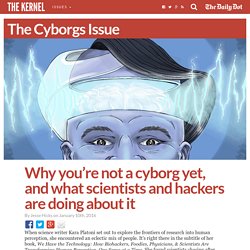
It’s right there in the subtitle of her book, We Have the Technology: How Biohackers, Foodies, Physicians, & Scientists Are Transforming Human Perception, One Sense at a Time. She found scientists chasing after a sixth taste while debating whether you can taste something you don’t have words to describe. She met perfumiers treating Alzheimer’s patients with scents that allowed them to unlock memories long thought forgotten. And of course, she met biohackers eagerly slicing open their own bodies to implant DIY technology. Her book covers a lot of ground: the five senses, what we think we know (and don’t know) about them, and how we might alter and augment them.
Forget Robots. We’ll Soon Be Fusing Technology With Living Matter. Bot & Dolly's Iris was responsible for the zero-g camera work in Gravity, which won this year's Oscar for best cinematography.

Josh Valcarcel/WIRED A prototype of the sensor BlueCity hopes to mount on the lids of trash cans everywhere to detect garbage levels and make waste collection less wasteful in the process. Boston Dynamics' Wildcat robot wowed the internet with a demo video that showed the dog-like creature navigating forest and ice.
Human enhancement. An electrically powered exoskeleton suit in development as of 2010 by Tsukuba University of Japan.
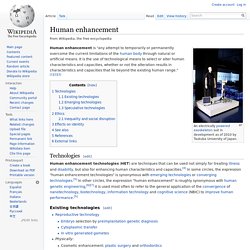
Human enhancement is "any attempt to temporarily or permanently overcome the current limitations of the human body through natural or artificial means. It is the use of technological means to select or alter human characteristics and capacities, whether or not the alteration results in characteristics and capacities that lie beyond the existing human range. " [1][2][3] Technologies[edit] Existing technologies[edit] The dilemma of human enhancement. How far can science push the limits of human life?

That was the theme of a Crosstalks webcast today, “The dilemma of human enhancement,” available for download. The show addressed questions like “Can we prevent people from dying? With implants, nanotechnology, artificial body parts and smart drugs we can enhance human physiology beyond our current limitations. But should we really pursue this? The dilemma of human enhancement - Crosstalks.tv.
Human Augmentation: Blurring the Line Between Biology & Technology - Futurism. Human Augmentation: Blurring the Line Between Biology & Technology Share This Tweet This Posted by Alex Klokus You must sign in or join to comment!

Join. Part Human, Part Machine, Cyborgs Are Becoming A Reality. Meeting a cyborg for the first time is a nerve-wracking experience.

We had arranged to meet in an area of London known as Silicon Roundabout. Near Old Street, the district is home to high-tech start-up firms, giving birth to Britain’s recent software industry boom. In its coffee bars, internet entrepreneurs and programmers share hot drinks and electronic dreams. One Step Beyond - The First Human Cyborg. Singularity: Kurzweil on 2045, When Humans, Machines Merge.
On Feb. 15, 1965, a diffident but self-possessed high school student named Raymond Kurzweil appeared as a guest on a game show called I've Got a Secret.
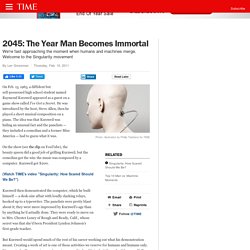
He was introduced by the host, Steve Allen, then he played a short musical composition on a piano. The idea was that Kurzweil was hiding an unusual fact and the panelists — they included a comedian and a former Miss America — had to guess what it was. On the show (see the clip on YouTube), the beauty queen did a good job of grilling Kurzweil, but the comedian got the win: the music was composed by a computer. Cyborg. A cyborg (short for "cybernetic organism") is a theoretical or fictional being with both organic and biomechatronic parts. The term was coined in 1960 by Manfred Clynes and Nathan S. Kline.[1] D. S. Halacy's Cyborg: Evolution of the Superman in 1965 featured an introduction which spoke of a "new frontier" that was "not merely space, but more profoundly the relationship between 'inner space' to 'outer space' – a bridge...between mind and matter. The cyborg era has started. What will the future hold for cyborgs.
Interview: Bruce Sterling on the Convergence of Humans and Machines. Bruce Sterling is a prominent science fiction writer and a pioneer of the cyberpunk genre. His cyberpunk novels Heavy Weather (1994), Islands in the Net (1988), Schismatrix (1985), The Artificial Kid (1980) earned him the nickname “Chairman Bruce”. Apart from his writings, Bruce Sterling is also a professor of internet studies and science fiction at the European Graduate School. He has contributed to several projects within the scheme of futurist theory, founded an environmental aesthetic movement, edited anthologies and he still continues to write for several magazines including Wired, Discover, Architectural Record and The Atlantic. 3D Printed Body Parts Go Mainstream. 3D printing technology has been around for two decades, but the price has come down in recent years and more people have been able to make use of it.
Consequently, we've started to be able to really tap into its vast potential. 3D printed products are being spewed out left, right and center; from the building blocks of houses to replica shark skin. It almost seems as though the capabilities are endless, and the technology is not anticipated to slow down any time soon. One really exciting application of 3D printing is the generation of body parts. The level of detail that this technology can produce often supersedes that of traditional methods, offering patients a superior fit or design, and they can often be produced at an impressively low cost. 9 Implants that make human healthy body even more useful. Here’s a list of 9 ways you can modify your body to be even more useful, from bionic implants to portable power generators. 1. RFID Chips – A nice and easy way to start out with body hacking is to implant an RFID chip into you.
An RFID chip is just a passive antenna that’s pre-configured to transmit a specific code when it’s brought near an RFID reader. Generally, RFID is used as a key of sorts; so for example, you can set up your computer or your phone to unlock only when you pick them up. Lab-Grown Body Parts Could Be Available Within 3 Years. Lab-grown body parts could be a reality within the next three years. They’re even going to be 3D printed. That’s what researchers in Swansea are saying. They hope to be among the first in the world to start using their process to benefit patients needing surgery to reconstruct body parts. The Process The multi-step process begins with harvesting cells from the patient’s cartilage.
After adding reagents to strengthen the structure, the jelly-like, newly printed part is shut back in the incubator to grow until its ready. Simply put, “we’re trying to grow new tissue using human cells,” said Prof Iain Whitaker, consultant plastic surgeon at the Welsh Centre for Burns and Plastic Surgery at Morriston Hospital. Can You Tell This CGI Skin Apart from Actual Skin? 3D Printed Skin Possible in About 5 Years. Self-healing sensor brings 'electronic skin' closer to reality. Digital Tattoo Gets Under Your Skin to Monitor Blood. Bioengineering doctoral student Kate Balaconis shines the iPhone reader against her tattooless arm. Electronic tattoo. An ultra-thin electronic device that attaches to the skin like a stick on tattoo can measure electrical activity of the human body like heart, brain waves and other vital signs without the bulky electrodes used in current monitoring.
Half man, half machine: Scientists engineer first 'cyborg' tissue - which uses living human cells and organic polymers. Harvard scientists created 'cyborg' skin from neurons, heart cells, and nano-electronic wiringWiring allows scientists to detect and respond to pH changes on the tissue's surface, the same as human skin By Daily Mail Reporter Published: 04:43 GMT, 30 August 2012 | Updated: 16:31 GMT, 30 August 2012. Cyborgs – scientists create biological tissue with embedded wiring. Flexible sensors turn skin into a touch-sensitive interface for mobile devices. iSkin is a thin, flexible, stretchable and visually customizable touch sensor that can be worn directly on the skin. Skin deep tech: Cicret bracelet aims to turn your arm into 'new tablet' The Cicret Bracelet: Like a tablet...but on your skin. Neurons in human skin perform advanced calculations.
Neurons in human skin perform advanced calculations, previously believed that only the brain could perform. This is according to a study from Umeå University in Sweden published in the journal Nature Neuroscience. Researchers grow cyborg tissue that can sense its environment. Smart Artificial Skin Could Give Prosthetic Limbs Feeling. Scientists have created a smart prosthetic skin that’s stretchy and warm like real skin, and is jammed with tiny sensors that can pick up a variety of environmental cues such as heat, pressure and moisture. Although it’s early days yet, the dream is that with further development, it could transmit sensory information to the brains of amputees to give prosthetic limbs feeling. Electronic Skin Can Store Data and Deliver Drugs. Robot Skin Can Feel Touch, Sense Chemicals, and Soak Up Solar Power.
New chemical circuits make becoming a cyborg even cooler. A Polish Company is Developing Liquid Body Armor. New material can restore the body's damaged tissue. New study shows simple conversion of skin cells into white blood-like cells. Transfusions of Synthetic Blood Are Right Around the Corner. Factory Made Blood Nearing Human Trials. Researchers closer to being able to change blood types. New Injection Gives You 30 Minutes of Oxygen Without Breathing. ‘Critical challenge’: Doctors can now 3D-print blood vessels. Scientists use 3D printing to make artificial blood vessels. Self-assembling organic material may create artificial veins. 3D Printed Device Detoxifies Blood Like a Liver. Intelligence: Patentability of 3D-Printed Organs. Tissue scaffold technology could help rebuild large organs. Harvard scientists grow human cells onto nanowire scaffold to form 'cyborg' skin.
Regeneration of cells - Regrowing finger. Artificial Intestines Near Reality : Discovery News. Lab-grown Guts Could Be Used to Treat Intestinal Disorders. Engineered Human Intestines Function Like the Real Thing in Mice. Human lung made in lab for first time. Goodbye Dialysis: Nanotechnology Used to Make Artificial Kidney. Scientists produce kidney tissue using stem cells from human skin. A First: Human Liver Created from Stem Cells. Bionic Pancreas Promises Big Boost in Health, Quality of Life for Type 1 Diabetics. Artificial Spleen ‘Cleans’ Blood of Pathogens. Scientists Grow Vocal Cord Tissue in a Lab for the First Time, and It Produces Sound. 3D Printed Airway Saves Toddler’s Life. First patient receives next-generation artificial heart replacement. Meet the first HEARTLESS man who is able to live without a heartbeat or a PULSE. Berkeley Researchers Create Robo-Muscles 1,000 Times Stronger Than Ours.
Spray-On Nanofibres Bind Surgical Wounds. This patient received the first 3d printed titanium ribcage. Soldiers could have their bones copied and 3D printed in case of injury - Futurism. A bioengineered patch that regrows damaged bones inside the body.